As we bear the brunt of the rainy season, we may all be thinking about past flood events. In this context, the wisdom of local environmental stewards and artists is worth listening to. Earlier this year, in February 2015, our MA Geography students attended a special workshop: a walk along the River Dodder with the Dodder Anglers, artist Martina O’Brien, and CREATE. This blog post introduces readers to the exhibition Casting Territory that the artist Martina O’Brien created with the fishermen. Subsequent posts written by some of our MA students will discuss their experiences.
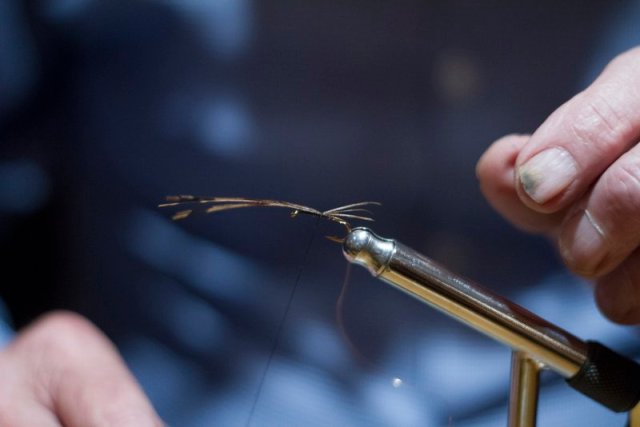
(Casting Territory (c) 2015 Martina O’Brien, Photograph by Michael Holly)
Although I can see him still—
The freckled man who goes
To a gray place on a hill
In gray Connemara clothes
At dawn to cast his flies—
It’s long since I began
To call up to the eyes
This wise and simple
— From The Fisherman, by William Butler Yeats [1]
Yeats was inspired to write a ‘Poem maybe as cold/And passionate as the dawn’ in tribute to an ‘imagined’ Fisherman, who represented an honest solitary figure in a grey Irish landscape. Unlike his earlier works, such as The Story of Wandering Angus (1899), the setting of The Fisherman is not a sensual, mythic place but rather a cold reality. As a nationalist critical of bourgeois Dublin society, Yeats’ tribute to ‘This wise and simple man’ elicited the readers’ empathy to imagine a different Ireland.[2]
With Casting Territory, visual artist Martina O’Brien similarly invites the general public to ‘call up to the eyes’ of fishermen and learn to see the River Dodder from their ‘wise’ and attentive perspective. In the Irish Dodder [An Dothra] means ‘turbulent’ and with recent flooding, the river has become a worrisome presence for many living alongside it. O’Brien explored the waterway with local residents through two other projects, Wasteland (2012) and Knitted Flood Wall (2012), and became aware of the Dodder Anglers’ care for the river, which sparked her interest in collaborating with the fishermen. The artist believes that the general public has much to learn from the fishermen, in particular, ‘how active citizenship can shape the urban environment,’ and what it means to be a custodian of a fragile environment.[3]
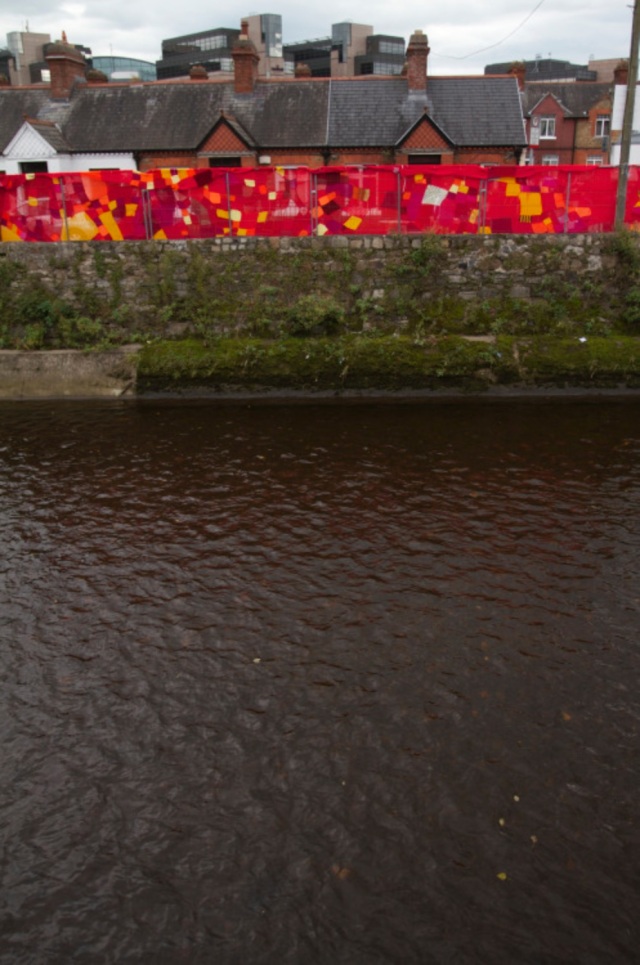
(Knitted Flood Wall (c) 2012, Martina O’Brien, image available here)
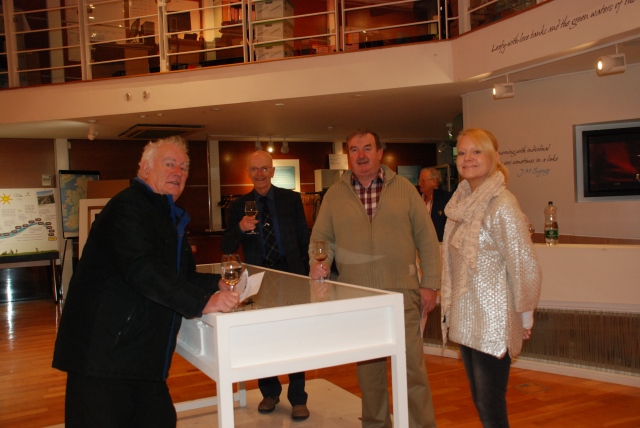
(Casting Territory exhibition launch 5 February 2015 at Waterways Centre, Grand Canal Dock, with artist Martina O’Brien and members of the Dodders Anglers Club. Photograph courtesy Helen McDonald.)
Fifty-six years ago, the Dodder Anglers Club started as an environmental activist group hoping to clean up the polluted river so that the trout and salmon would return. Their 1000-strong group now draws members from across the city, Ireland and even Europe, and they regularly host competitions and clean-up days. In their quest for the ‘wiley’ wild brown trout, these environmental stewards observe the rich minutiae of the river, its velocity, water quality, and flora and fauna.[4] Their unique understanding of the city extends across the vast 26-kilometre long catchment area of the river, running through Tallaght, Firhouse, Rathfarnham, Templeogue, Rathgar, Milltown, Clonskeagh, Donnybrook and into Ballsbridge before entering the Liffey near Ringsend and the Grand Canal Dock.
Using their fly-tying craft, the fishermen have made lures to entice other city dwellers to “a dialogue about being a guardian of the river”.[5] Some of their creative “flies” call attention to the complex natural-human relationships of the urban ecosystem. Inundation, Reservoir, Rising Again and Stolen Water for example, are small-scale studies of the river’s delicate environment, including its dramatic flood-prone nature and our problematic attempts to control the river’s flow. Water Meter Fly questions whether water should become privatised, echoing current environmental controversies about water charges, whereas Witches Knickers Fly, Remnants, and Junk Fly harkens back to the Dodder Anglers previous work, reminding Dubliners about the consequences of our ‘throw away’ society – namely that our trash pollutes our shared world and kills lives. Lures such as Study of Time on the Dodder questions our loyalty to the many corporate icons that come and go in our city, and instead reiterates the river’s reassuring constancy, running its course over hundreds of years, a presence that will remain long after we are gone.
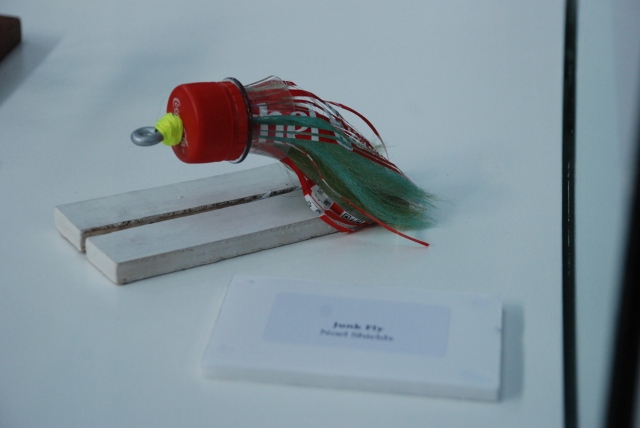
(Junk Fly in Casting Territory. Photograph courtesy Helen McDonald)
The fishermen have also connected difficult political pasts to the restorative powers of the river, such as Lord Santry Butcher. The Miami lure acknowledges the legacy of the annual Dodders Anglers Association Miami Cup fishing competition – named in honour of the Miami Showband who donated the cup to the Anglers – as well as the painful memory of the vicious murder of the band’s members in a paramilitary attack in 1975. The American and Russian Embassy Fly considers how the river and the Anglers Association has helped to create a shared community that has bridged national divisions, even during the tense periods of Cold War.
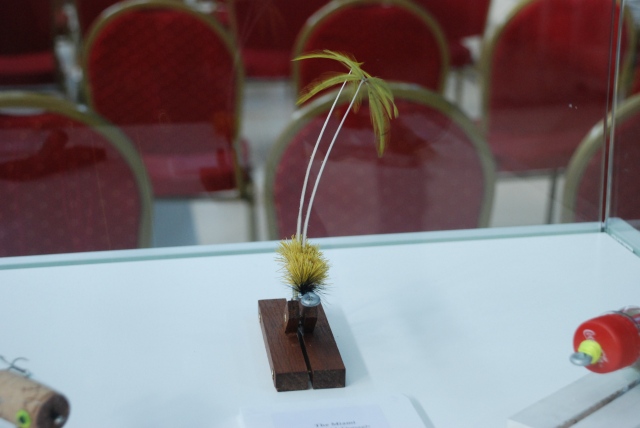
(The Miami in Casting Territory. Photograph courtesy Helen McDonald)
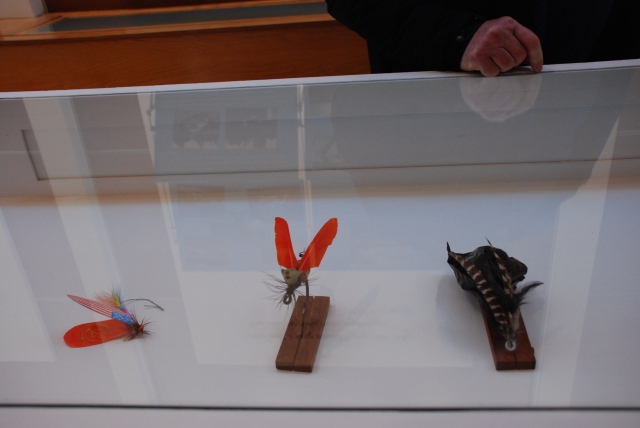
(American and Russian Embassy Fly (on left) with other flies in Casting Territory. Photograph courtesy Helen McDonald)
In February 2015 the public had an opportunity to follow the fishermen’s casting of lines across and through the space-times of the Dodder by visiting three eddies along the river: the RUA RED South Dublin Arts Centre in Tallaght, the Royal Dublin Society Library and Archives in Ballsbridge, and the Waterways Ireland Visitors Centre at the Grand Canal Quay. Seeing our urban environment through the eyes of these wise fishermen and custodians, we may begin to share responsibility for ‘the little silver cords’ of An Dothra and our city. Who knows? We may even begin to look for the elusive sea trout that inhabits the dreams of the anglers and begin fishing for the river with them.
Although you hide in the ebb and flow
Of the pale tide when the moon has set,
The people of coming days will know
About the casting out of my net …
— From The Fish by William Butler Yeats [1]
Dr. Karen E. Till is a Senior Lecturer at Maynooth University and Director of the MA in Geography.
Notes
[1] See Yeats. 1916. Poetry, Volume 7.
[2] See Seamus Heaney. 1998. Opened Ground: Selected Poems 1966–1996 (New York: FSG), 346.
[3] Artist Martina O’Brien, January 2015, personal correspondence.
[4] For more about the Dodder Anglers, see the accompanying videos, Artificial Patterns, Invisible Patterns, Well Established Patterns (O’Brien, 2015) and Paddy Conneff’s (2012) poem Culvert about the Dodder and the Slang.
[5] O’Brien, January 2015, personal correspondence.
[…] Source: Fishing for the River: An Dothra Guardians in Martina O’Brien’s ‘Casting Territory’ […]
LikeLike
[…] Martina O’Brien, and CREATE. The following blog post by Aoife Kavanagh follows up on an earlier post by Karen Till, which introduced readers to the exhibition Casting Territory created by the artist […]
LikeLike